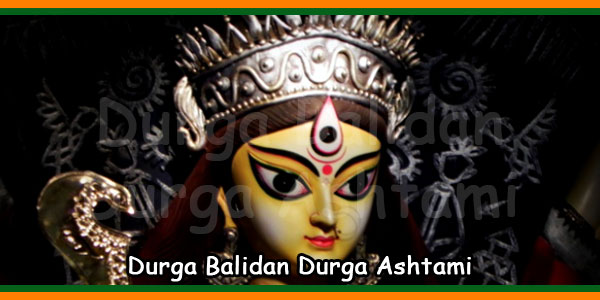It is necessary that Balidan of Maha Navami should always be performed on Uday Vyapini Navami. As per Nirnaysindhu, Aparahna Kala is the best time to perform Balidan.
Depending on the starting time of Navami Tithi on the previous day, it may happen that Maha Navami fasting and Puja occur one day before Durga Balidan. If Navami Tithi begins before Sanyakal on Ashtami, then both Ashtami Puja and Navami Puja can be performed on Ashtami Tithi. If it is the case, then all rituals like Ashtami Puja, Sandhi Puja and Navami Puja are performed together on Ashtami Tithi. However, it may be noted that Durga Balidan is always done on Navami Tithi only.

Devotees who refrain from animal sacrifice can perform symbolic Bali with vegetables like banana, cucumber or pumpkin. As per Hindu scriptures, Brahmins are prohibited from doing animal sacrifice and hence they do only symbolic Bali. Even at the famous Belur Math in West Bengal only symbolic Bali is performed with banana, white pumpkin and sugar cane during Navami Puja. White pumpkin used for Durga Balidan is called Kushmanda.
Importance and Significance Durga Ashtami Festival:
Maha Ashtami festival begins with Mahasnan and Shodashopachar Pooja which is quite similar to Maha Saptami Pooja. Sandhi Puja begins when Ashtami Tithi ends and Navami Tithi starts. Durga Balidan happens on Uday Vyapini Navami Tithi and some devotees perform bali on pumpkin while others sacrifice animals. On the same day they light 108 earthen lamps during Sandhi Kaal. It is said that Goddess Kali appeared from the forehead of Maa Durga on this auspicious day. Temples conduct special pooja’s on those days. On the tenth day of Navratri, devotees immerse the idol of Goddess Durga in the sacred water body on the evening of Dashami. This traditional ritual symbolizes that Mother Goddess descends to the Earth on Shashti (sixth day) and returns to her abode on Dashami (tenth day).
On the day of Durga Pooja, people celebrate the festival and feast. But this occasion is much more than this. It is about the triumph of goodness over all the wrong things. Goddess Durga is the almighty savior for all her devotees. Celebrating this festival helps in socializing and reunions after a long span of time.
Devotees install nine earthen pots and invoke Goddess image in it. Nine forms of Durga are been worshipped during Maha Ashtami Pooja and some young unmarried girls are treated as Goddess. This ritual is known as Kumari Pooja and performing this ritual on a single day during Durga Pooja is preferred on Maha Ashtami. Navami Homa is the most important ritual during Durga Pooja and devotees perform Homa at the end of Navami Pooja.
On the last day of Navratri, devotees immerse the idol of Goddess Durga in the sacred water body on the evening of Dashami. This ritual symbolizes that Mother Goddess descends to the Earth on Shashti, on the sixth day and returns to her abode on Dashami. One can say that Durga Pooja is not just a festival but a big social event where socializing and catch up plans are made. On this day, devotees worship nine forms of Durga and even some young unmarried girls are been treated as Goddess and are being worshiped. This ritual is known as Kumari Pooja and performing this ritual on a single day during Durga Pooja is preferred on Maha Ashtami. This ritual is known as Kumari Pooja and performing this ritual on a single day during Durga Pooja is preferred on Maha Ashtami.
Happy Durga Ashtami to everyone out there! May Goddess Durga bless you and your loved ones on this auspicious day.
